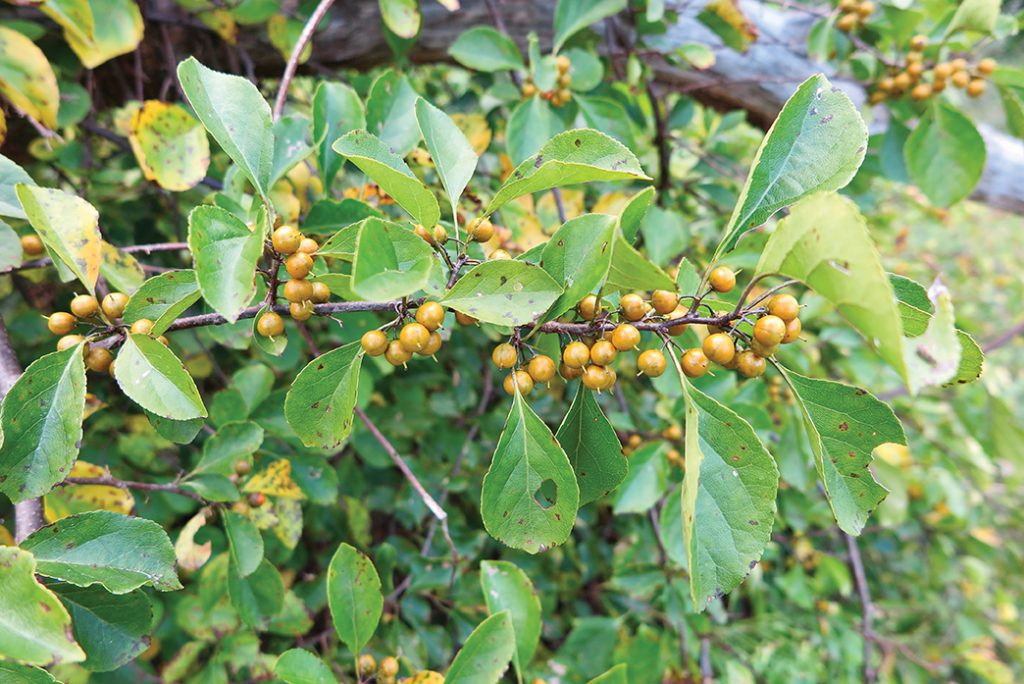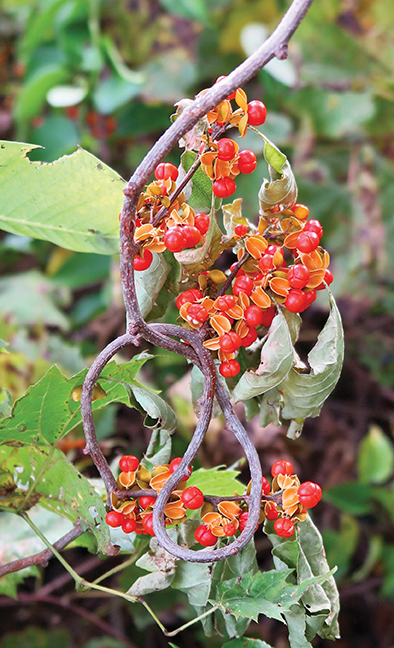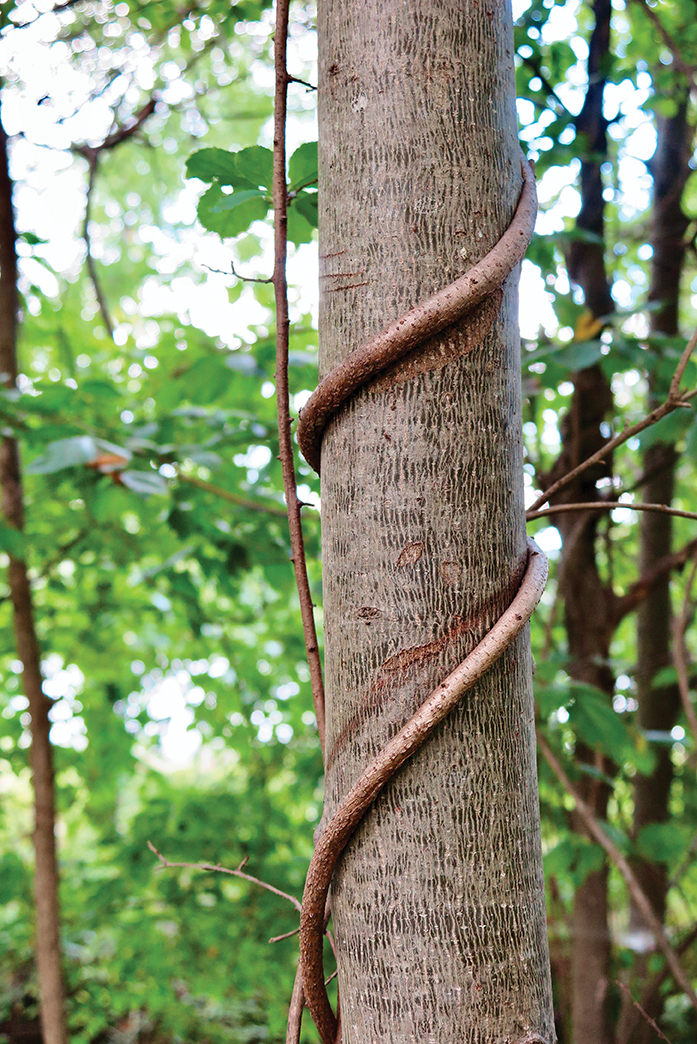

Despite its cause for concern in the United States, traditional Chinese medicine considers Celastrus orbulatus an important medicinal plant, used as an anti-inflammatory and for the treatment of rheumatoid arthritis and bacterial infections.
Beautiful berries make this invasive vine a favorite for seasonal garlands,
but it’s listed as a high threat in the Northeast, making it truly bittersweet.
I have a memory from childhood of riding in the family station wagon along Route One and my mother imploring my dad to pull over so she could collect some of that beautiful bittersweet vine growing along the roadside. It was early fall, and visions of seasonal decorations were dancing though her head.
She was not alone. For years people helped to spread the non-native Oriental bittersweet vine (Celastrus orbiculatus) simply by admiring, collecting, and then disposing of it in their backyard brush pile. Along many natural and manmade edges—the banks of the Connecticut River, the beleaguered boundaries of Interstate 91—this familiar vine has become ubiquitous.
By 2017 the Connecticut Department of Energy and Environmental Protection had posted on its website the plea to “Consider Alternatives When Decorating this Season,” reminding the public that a 2004 state law now prohibits the “moving, selling, purchasing, transplanting, cultivating, or distribution” of Oriental bittersweet, and asking residents to notify the state of violators.
It’s likely that you have seen our introduced bittersweet, even if you’re thinking you are not familiar with it. It’s the fall fruit that is most conspicuous about this plant—striking clusters of fire-engine red berries with a harvest gold outer shell that flips up when mature. They are in their glory when all the surrounding leaves have fallen. Small mammals and especially birds find these fall fruit displays just as irresistible as my mom did, and with much the same result: bittersweet has a flawless dispersal technique. There’s a reason that field hedgerows and wooded buffers along the Connecticut River are loaded with bittersweet: birds that consume the berries often lighten their load before taking flight from these vegetated edges, providing a self-fertilized starter kit for the seeds with every dropping.

The invasive Oriental bittersweet has red berries whereas the American bittersweet has yellow berries and is increasingly hard to find.
As with all of our most challenging non-native invasive plants, there is human history behind how they arrived, and because New England was colonized early in the country’s history, these plants are now well established. Peter Del Tredici, emeritus Senior Research Scientist at the Arnold Arboretum in Boston, wrote in an interesting account of this plant’s history in the northeast, that “Bittersweet seeds went from the wilds of Japan to Flushing [New York] to Boston to England and then back to New York where they began to naturalize.”
The first public offering of bittersweet seeds locally came from the Kissena Nurseries in New York in 1871. Sometime later a glowing description from the Arnold Arboretum newsletter referenced the establishment of this plant, with, among its descriptors, “sometimes producing stems twelve or fifteen feet long during a single season, and immense masses of foliage.” By 1949 bittersweet was described by “a panel of eminent horticulturalists” in the best-selling book Shrubs and Vines for American Gardens as “among the most ornamental of the ninety-one vines under observation.”
But even as early as the mid-1940s there was forewarning of bittersweet’s invasiveness. And in a 1964 issue of American Nurseryman the plant’s much-loved features were tempered by the acknowledgement that the “vines are vigorous twiners and can become vicious pests.” Despite this, the National Arboretum in Washington, DC, distributed this plant in the mid-sixties to nurseries and public gardens in 30 states, and it was recommended for use along highway rights of way.
Oriental bittersweet has all the markers of a good invasive plant: rapid growth rate, capacity to reproduce multiple ways—prolific seed production and the ability to make new plants from root suckers—as well as a wide tolerance of light conditions. Glen Dreyer, former Director of the Connecticut College Arboretum, found much higher pollen and seed viability in the invasive bittersweet compared to our native plant. Oriental bittersweet can even detect far red light that is transmitted and reflected by plants nearby, suggesting that it may have the ability to grow toward potential support vegetation on its climb to the top of the canopy, and sun.
Unlike other non-native invasive plants, Oriental bittersweet seeds are short-lived, although this is offset by the sheer numbers of available seeds and at least one study showing a 90% establishment rate. There are, however, some natural deterrents to its success. It is intolerant of waterlogged soils. While it is possible for latent, bird-dispersed seeds of bittersweet to employ what some researches have dubbed a “sit and wait” strategy in closed canopy forests, it has also been found that thick oak leaf litter, with specific reference to red oak, may retard seedling emergence.
Amidst this there is, receding into the background, our native bittersweet vine, American bittersweet, Celastrus scandens. Although similar—they are both vines with slightly serrated, oval to round leaves arranged alternately along the stem—the native bittersweet bears its flowers and fruits at the end of its branches (rather than where the leaf intersects the branch), and the outer shell of the brightly colored fruit is orange, rather than yellow. Over time, these two bittersweets are hybridizing, with a lopsided advantage to the Oriental cousin because of its robust pollen production. Because of this, American bittersweet is ranked by all the New England states (except New Hampshire, due to lack of, or conflicting, information) as either uncommon, extremely rare, or a “species of special concern.”

Bittersweet vine lacks tendrils and climbs by means of twining shoots that can eventually grow above vegetation to reach the tops of the highest trees, often strangling the trunk of its host tree.
The best way to stem the tide of this species, and all the other non-native invasive plants, is to know what you’re planting. Seeds, garlands, and stock of Oriental bittersweet are, incredulously, available online—some misidentified as native, but most marketed as Oriental bittersweet. Early detection is also essential to realistically preventing spread, as is maintaining native plant communities (including thick leaf litter) and knowing that disturbance—even natural blowdowns in the woods—can create an opportunity for invasion.
Dealing with existing vines, like most in this category of troublemaker, takes persistence. The tools include mechanical cutting, mowing, or grubbing out the roots, with the best time for action being before new seeds are set. Goats and sheep are pretty effective as well. Herbicides can provide initial control but are rarely an advisable long-term solution. And disposal of plants and especially seeds is also critical (dumpster or burn). There are many great online resources that provide guidance about managing this plant.
We have so much to address in this time of a changing climate, with big-stakes losses in the balance. Research out of Connecticut College has quantified the impacts of bittersweet on how our local woodlands and fields evolve. Loss of nature’s grand diversity is not only a threat to people, it’s sad. But that doesn’t render us without the means to make a difference.
If you’re looking for an alternative vine to plant, try the native Trumpet Honey-suckle (Lonicera sempervirens) or Virginia-creeper (Parthenocissus quinquefolia), increasingly made available at local native plant sales. Check your local university extension office to find out more.
Leaving bittersweet for the more upbeat—in 2022, a “Gardening for Good” column will explore the many ways that our backyard gardens and landscapes can be a part of the solution to seemingly intractable environmental issues. Just in time for spring.
Judy Preston is a local ecologist active in the Connecticut River Estuary.

